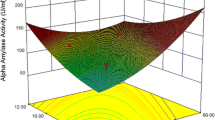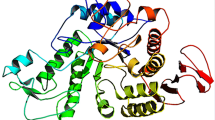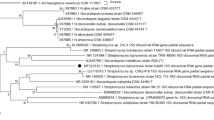Abstract
A newly isolated amylolytic strain was identified as Bacillus cereus spH1 based on 16S and 16-23S gene sequencing (Accession numbers OP811441.1 and OP819558, respectively), optimization strategies, using one variable at time (OVAT) and Plackett–Burman design, were employed to improve the alpha-amylase (α-amylase) production. Condition inferred revealed that the optimal physical parameters for maximum enzyme production were 30 °C, pH 7.5, and 12 h of incubation, using tryptone, malt extract, orange (Citrus sinensis) peels, crab (Portunus segnis) shells, calcium, and sodium chloride (NaCl) as culture medium. The full factorial design (FFD) model was observed to possess a predicted R2 and adjusted R2 values of 0.9788 and 0.9862, respectively, and it can effectively predict the response variables (p = 0). Following such efforts, α-amylase activity was increased 141.6-folds, ranging from 0.06 to 8.5 U/mL. The ideal temperature and pH for the crude enzyme activity were 65 °C and 7.5, respectively. The enzyme exhibited significant stability, with residual activity over 90% at 55 °C. The maltose was the only product generated during the starch hydrolysis. Moreover, the Bacillus cereus spH1 strain and its α-amylase were used in the treatment of effluents from the pasta industry. Germination index percentages of 143% and 139% were achieved when using the treated effluent with α-amylase and the strain, respectively. This work proposes the valorization of agro-industrial residues to improve enzyme production and to develop a green and sustainable approach that holds great promise for environmental and economic challenges.








Similar content being viewed by others
Data Availability
All the relevant data have been provided in the manuscript. Links to the submitted sequences: Bacillus cereus strain H1 16S ribosomal RNA gene, partial sequence: https://www.ncbi.nlm.nih.gov/nucleotide/OP811441.1?report=genbank&log$=nuclalign&blast_rank=1&RID=TZEBW479016; Bacillus cereus 16S-23S ribosomal RNA intergenic spacer and 23S ribosomal RNA gene, partial sequence: https://www.ncbi.nlm.nih.gov/nucleotide/OP819558.1?report=genbank&log$=nuclalign&blast_rank=1&RID=TZEPY6CJ013.
References
Abd-Elaziz AM, Karam EA, Ghanem MM et al (2020) Production of a novel α-amylase by Bacillus atrophaeus NRC1 isolated from honey: purification and characterization. Int J Biol Macromol 148:292–301. https://doi.org/10.1016/j.ijbiomac.2020.01.120
Abd-Elhalim BT, Gamal RF, El-Sayed SM, Abu-Hussien SH (2023) Optimizing alpha-amylase from bacillus amyloliquefaciens on bread waste for effective industrial wastewater treatment and textile desizing through response surface methodology. Sci Rep 13:19216. https://doi.org/10.1038/s41598-023-46384-6
Afrisham S, Badoei-Dalfard A, Namaki-Shoushtari A, Karami Z (2016) Characterization of a thermostable, cacl 2 -activated and raw-starch hydrolyzing alpha-amylase from Bacillus licheniformis AT70: production under solid state fermentation by utilizing agricultural wastes. J Mol Catal B Enzym 132:98–106. https://doi.org/10.1016/j.molcatb.2016.07.002
Ahmed SA, Mostafa FA, Helmy WA, Abdel-Naby MA (2017) Improvement of bacterial α-amylase production and application using two steps statistical factorial design. Biocatal Agric Biotechnol 10:224–233. https://doi.org/10.1016/j.bcab.2017.03.004
Ali EH, El-Nagdy MA, Al-Garni SM et al (2017) Enhancement of alpha amylase production by Aspergillus flavus AUMC 11685 on mandarin (Citrus reticulata) peel using submerged fermentation. Eur J Biol Res 7(3):154–64
Alonazi M, Karray A, Badjah-Hadj-Ahmed AY, Ben Bacha A (2020) Alpha amylase from Bacillus pacificus associated with brown algae Turbinaria ornata: cultural conditions, purification, and biochemical characterization. Processes 9:16. https://doi.org/10.3390/pr9010016
Amin K, Tranchimand S, Benvegnu T et al (2021) Glycoside hydrolases and glycosyltransferases from hpyerthermophilic archea: insights on their characteristics and applications in biotechnology. Biomolecules 11:1557. https://doi.org/10.3390/biom11111557
Anupama A, Jayaraman G (2011) Detergent stable, halotolerant α-amylase from Bacillus aquimaris vitp4 exhibits reversible unfolding. Int J Appl Biol Pharm Technol 2:366–376
Awasthi MK, Sarsaiya S, Wainaina S et al (2021) Techno-economics and life-cycle assessment of biological and thermochemical treatment of bio-waste. Renew Sustain Energy Rev 144:110837. https://doi.org/10.1016/j.rser.2021.110837
Bejaoui S, Ghribi F, Hatira S et al (2017) First investigation in the biochemical analysis of the invasive crab portunus segnis from Tunisian waters. J Am Oil Chem Soc 94:673–682. https://doi.org/10.1007/s11746-017-2987-x
Bhatia SK, Jagtap SS, Bedekar AA et al (2020) Recent developments in pretreatment technologies on lignocellulosic biomass: effect of key parameters, technological improvements, and challenges. Bioresour Technol 300:122724. https://doi.org/10.1016/j.biortech.2019.122724
Bhatt K, Lal S, Srinivasan R, Joshi B (2020) Bioconversion of agriculture wastes to produce α-amylase from bacillus velezensis KB 2216: purification and characterization. Biocatal Agric Biotechnol 28:101703. https://doi.org/10.1016/j.bcab.2020.101703
Bouaziz A, Horchani H, Ben Salem N, Gargouri Y, Sayari A (2011) Expression, purification of a novel alkaline Staphylococcus xylosus lipase acting at high temperature. Biochem Eng J 54(2):93–102
Caliskan Ozdemir S, Coleri Cihan A, Kilic T, Cokmus C (2016) Optimization of thermostable alpha-amylase production from Geobacillus sp. D413. J Microbiol Biotechnol Food Sci 6:689–694. https://doi.org/10.15414/jmbfs.2016.6.1.689-694
Chouchane H, Hoekstra AY, Krol MS, Mekonnen MM (2015) The water footprint of Tunisia from an economic perspective. Ecol Indic 52:311–319. https://doi.org/10.1016/j.ecolind.2014.12.015
Crini G, Lichtfouse E (2018) Advantages and disadvantages of techniques used for wastewater treatment. Environ Chem Lett 17:145–155. https://doi.org/10.1007/s10311-018-0785-9
Deljou A, Arezi I (2016) Production of thermostable extracellular α-amylase by a moderate thermophilic Bacillus licheniformis isolated from Qinarje Hot spring (Ardebil Prov. of Iran). Periodicum Biologorum 118(4):405–416. https://doi.org/10.18054/pb.v118i4.3737
Deshmukh RK, Naik JB (2013) Diclofenac sodium-loaded Eudragit® microspheres: optimization using statistical experimental design. J Pharm Innov 8:276–287. https://doi.org/10.1007/s12247-013-9167-9
Duque SMM, Dizon EI, Merca FE, Flores DM (2016) Optimization of raw-starch-digesting amylase (RSDA) production medium for Enterococcus faecium DMF78. Int Food Res J 23:1280–1288
Elyasi Far B, Dilmaghani A, Yari Khosroushahi A (2020) In silico study and optimization of Bacillus megaterium alpha-amylases production obtained from honey sources. Curr Microbiol 77:2593–2601. https://doi.org/10.1007/s00284-020-02019-x
Embaby AM, Masoud AA, Marey HS et al (2014) Raw agro-industrial orange peel waste as a low-cost effective inducer for alkaline polygalacturonase production from bacillus licheniformis shg10. SpringerPlus 3:327. https://doi.org/10.1186/2193-1801-3-327
Esparza I, Jiménez-Moreno N, Bimbela F et al (2020) Fruit and vegetable waste management: conventional and emerging approaches. J Environ Manag 265:110510. https://doi.org/10.1016/j.jenvman.2020.110510
Farias TC, Kawaguti HY, Bello Koblitz MG (2021) Microbial amylolytic enzymes in foods: technological importance of the bacillus genus. Biocatal Agric Biotechnol 35:102054. https://doi.org/10.1016/j.bcab.2021.102054
Food and Agricultural Organization Statistics (2021). https://www.fao.org/faostat/fr/#home
Hu Q, Wu Q, Dai B et al (2022) Fermentation optimization and amylase activity of endophytic Bacillus velezensis D1 isolated from corn seeds. J Appl Microbiol 132:3640–3649
Industrial enzymes market size, share, growth opportunities (2023) Market-report https://www.marketsandmarkets.com/Market-Reports/industrial-enzymes-market-237327836.html. Accessed 18 Nov 2023a
Iram N, Shakir HA, Irfan M et al (2021) Statistical optimization of amylase production using grape fruit peels in submerged fermentation. Acta Sci Technol 43(1):e50538. https://doi.org/10.4025/actascitechnol.v43i1.50538
Keskin Gündoğdu T, Deniz İ, Çalışkan G et al (2014) Experimental design methods for bioengineering applications. Crit Rev Biotechnol 36:368–388. https://doi.org/10.3109/07388551.2014.973014
Kikani BA, Kourien S, Rathod U (2019) Stability and thermodynamic attributes of starch hydrolyzing α-amylase of Anoxybacillus rupiensis TS-4. Starch-Stärke 72(1–2):1900105. https://doi.org/10.1002/star.201900105
Kini UA, Shettar M, Sharma S et al (2019) Effect of hygrothermal aging on the mechanical properties of nanoclay-glass fiber-epoxy composite and optimization using full factorial design. Mater Res Express 6:065311. https://doi.org/10.1088/2053-1591/ab0d68
Lakshmi SS, Mahesh CH, Gayatri K et al (2020) Statistical optimization of amylase production and its purification from a palm wine isolate Bacillus sp., Q-164. Biocatal Agric Biotechnol 29:101820. https://doi.org/10.1016/j.bcab.2020.101820
Li S-W, He H, Zeng RJ, Sheng G-P (2017) Chitin degradation and electricity generation by Aeromonas hydrophila in microbial fuel cells. Chemosphere 168:293–299. https://doi.org/10.1016/j.chemosphere.2016.10.080
Londoño-Hernandez L, Ruiz HA, Toro CR et al (2020) Advantages and progress innovations of solid-state fermentation to produce industrial enzymes. Microorg Sustain. https://doi.org/10.1007/978-981-15-1710-5_4
Mojumdar A, Deka J (2019) Recycling agro-industrial waste to produce amylase and characterizing amylase–gold nanoparticle composite. Int J Recycl Org Waste Agric 8:263–269. https://doi.org/10.1007/s40093-019-00298-4
Mouna Imen O, Mahmoud K (2015) Statistical optimization of cultural conditions of an halophilic alpha-amylase production by halophilic Streptomyces sp. grown on orange waste powder. Biocatal Agric Biotechnol 4:685–693. https://doi.org/10.1016/j.bcab.2015.08.011
Niyomukiza S, Owino W, Mathara JM et al (2022) Isolation, purification and biochemical characterization of alkaline α-amylase from Bacillus subtilis strain W3SFR5 isolated from kitchen wastes. Appl Food Biotechnol 9:9–19
Nusrat A, Rahman SR (2007) Comparative studies on the production of extracellular α-amylase by three mesophilic Bacillus isolates. Bangladesh J Microbiol 24:129–132. https://doi.org/10.3329/bjm.v24i2.1257
Ojha SK, Singh PK, Mishra S et al (2020) Response surface methodology-based optimization and scale-up production of amylase from a novel bacterial strain, Bacillus aryabhattai KIIT BE-1. Biotechnol Rep 27:e00506. https://doi.org/10.1016/j.btre.2020.e00506
Okino-Delgado CH, Zanutto-Elgui MR, do Prado DZ et al (2019) Enzymatic bioremediation: current status, challenges of obtaining process, and applications. In: Arora P (ed) Microbial metabolism of xenobiotic compounds. Microorganisms for sustainability, vol 10. Springer, Singapore, pp 79–101. https://doi.org/10.1007/978-981-13-7462-3_4
Oueslati W, Zrelli S, Bouchleghem S et al (2019) First study on the interest of the determination of the total volatile basic nitrogen in the blue crab (Portunus segnis) in Tunisia. J New Sci 68:4140–4146
Ousaadi MI, Merouane F, Berkani M et al (2021) Valorization and optimization of agro-industrial orange waste for the production of enzyme by halophilic Streptomyces sp. Environ Res 201:111494. https://doi.org/10.1016/j.envres.2021.111494
Phanphet S, Bangphan S (2021) Application of full factorial design for optimization of production process by turning machine. J Tianjin Univ Sci Technol 54:35–55
Plackett RL, Burman JP (1946) The design of optimum multifactorial experiments. Biometrika 33:305–325. https://doi.org/10.1093/biomet/33.4.305
Rajagopalan G, Krishnan C (2008) Optimization of medium and process parameters for a constitutive α-amylase production from a catabolite derepressed Bacillus subtilis KCC103. J Chem Technol Biotechnol 83:654–661. https://doi.org/10.1002/jctb.1845
Raul D, Biswas T, Mukhopadhyay S et al (2014) Production and partial purification of alpha amylase from Bacillus subtilis (mtcc 121) using solid state fermentation. Biochem Res Int 2014:1–5. https://doi.org/10.1155/2014/568141
Rehman A, Saeed A, Asad W, Kiran T, Baloch MN, Eijaz S (2019) Optimization of physicochemical parameters for maximum amylase production by indigenously isolated Bacillus cereus AS2 strain. Pakistan J Pharm Sci 32(2):889–894
Rivas B, Torrado A, Torre P et al (2008) Submerged citric acid fermentation on orange peel autohydrolysate. J Agric Food Chem 56:2380–2387. https://doi.org/10.1021/jf073388r
Saha SP, Mazumdar D (2019) Optimization of process parameter for alpha-amylase produced by bacillus cereus Amy3 using one factor at a time (OFAT) and central composite rotatable (ccrd) design based response surface methodology (RSM). Biocatal Agric Biotechnol 19:101168. https://doi.org/10.1016/j.bcab.2019.101168
Salem K, Elgharbi F, Ben Hlima H et al (2020) Biochemical characterization and structural insights into the high substrate affinity of a dimeric and ca2+ independent Bacillus subtilis α-amylase. Biotechnol Prog 36(4):e2964. https://doi.org/10.1002/btpr.2964
Salem K, Jabalera Y, Puentes-Pardo JD, Vilchez-Garcia J, Sayari A, Hmida-Sayari A, Jimenez-Lopez C, Perduca M (2021) Enzyme storage and recycling: nanoassemblies of α-amylase and xylanase immobilized on biomimetic magnetic nanoparticles. ACS Sustain Chem Eng 9(11):4054–4063
Sarmiento F, Peralta R, Blamey JM (2015) Cold and hot extremozymes: industrial relevance and current trends. Front Bioeng Biotechnol. https://doi.org/10.3389/fbioe.2015.00148
Sharif S, Shah AH, Fariq A et al (2023) Optimization of amylase production using response surface methodology from newly isolated thermophilic bacteria. Heliyon 9(1):e12901. https://doi.org/10.1016/j.heliyon.2023.e12901
Shaukat M (2022) Determination and optimization of crude extracellular amylase extracted from different Bacillus species. Pakistan J Sci 73(1):1–12. https://doi.org/10.57041/pjs.v73i1.633
Soares MR, Matsinhe C, Belo S et al (2013) Phytotoxicity evolution of biowastes undergoing aerobic decomposition. J Waste Manag 2013:1–8. https://doi.org/10.1155/2013/479126
Sundarram A, Murthy TPK (2014) α-amylase production and applications: a review. Appl Environ Microbiol 2:166–175
Suresh PV, Kudre TG, Johny LC (2017) Sustainable valorization of seafood processing by-product/discard. In: Singhania R, Agarwal R, Kumar R, Sukumaran R (eds) Waste to wealth. Energy, environment, and sustainability. Springer, Singapore, pp 111–139. https://doi.org/10.1007/978-981-10-7431-8_7
Tiwari SP, Srivastava R, Singh CS, Shukla K, Singh RK, Singh P et al (2015) Amylases: an overview with special reference to alpha amylase. J Global Biosci 4(1):1886–1901
Tripathi N, Hills CD, Singh RS, Atkinson CJ (2019) Biomass waste utilisation in low-carbon products: harnessing a major potential resource. npj Clim Atmos Sci 2:35. https://doi.org/10.1038/s41612-019-0093-5
Uygut MA, Tanyildizi MŞ (2016) Optimization of alpha-amylase production by bacillus amyloliquefaciens grown on orange peels. Iran J Sci Technol Trans A Sci 42:443–449. https://doi.org/10.1007/s40995-016-0077-
Venugopal V (2021) Valorization of seafood processing discards: bioconversion and bio-refinery approaches. Front Sustain Food Syst 5:611835. https://doi.org/10.3389/fsufs.2021.611835
Wu X, Wang Y, Tong B et al (2018) Purification and biochemical characterization of a thermostable and acid-stable alpha-amylase from Bacillus licheniformis B4423. Int J Biol Macromol 109:329–337. https://doi.org/10.1016/j.ijbiomac.2017.12.004
Yassin SN, Jiru TM, Indracanti M (2021) Screening and characterization of thermostable amylase-producing bacteria isolated from soil samples of Afar Region, and molecular detection of amylase-coding gene. Int J Microbiol 2021:1–14. https://doi.org/10.1155/2021/5592885
Acknowledgements
This work is part of a doctoral thesis by Bouthaina Ben Hadj Hmida, whose research was financially supported by the Ministry of Higher Education and Scientific Research (Tunisia) through a grant to the Laboratory of Biochemistry and Enzymatic Engineering of Lipases-Engineering National School of Sfax- University of Sfax-Tunisia.
Author information
Authors and Affiliations
Contributions
BBHH: Data curation, Formal analysis, Investigation, Methodology, Writing—Original Draft. SBM and AF: Investigation, Methodology, Writing — Review & Editing. AS and AH-S: Conceptualization, Writing — Review & Editing, Supervision, Project administration.
Corresponding author
Ethics declarations
Conflict of interest
The authors declare that they have no known competing financial interests or personal relationships that could have appeared to influence the work reported in this paper.
Ethical approval
Not applicable.
Consent to Publish
All authors have consent to publish the paper.
Consent to participate
All authors have consent to participate in the study.
Statement of informed consent
The research does not involve human participants and animal experiments.
Rights and permissions
Springer Nature or its licensor (e.g. a society or other partner) holds exclusive rights to this article under a publishing agreement with the author(s) or other rightsholder(s); author self-archiving of the accepted manuscript version of this article is solely governed by the terms of such publishing agreement and applicable law.
About this article
Cite this article
Ben Hadj Hmida, B., Ben Mabrouk, S., Fendri, A. et al. Optimization of newly isolated Bacillus cereus α-amylase production using orange peels and crab shells and application in wastewater treatment. 3 Biotech 14, 119 (2024). https://doi.org/10.1007/s13205-024-03962-3
Received:
Accepted:
Published:
DOI: https://doi.org/10.1007/s13205-024-03962-3




